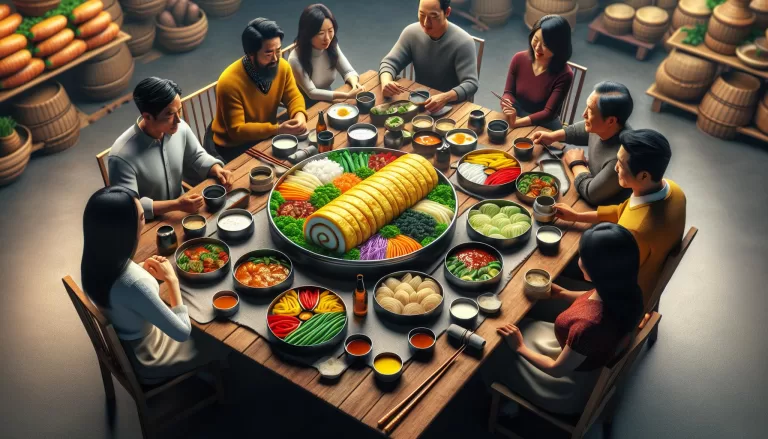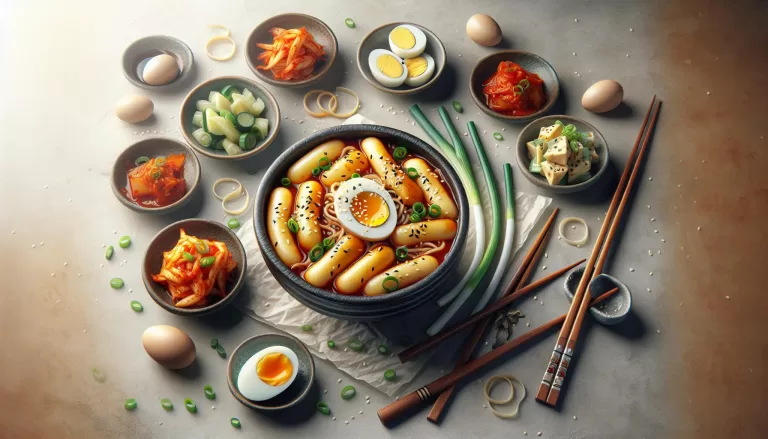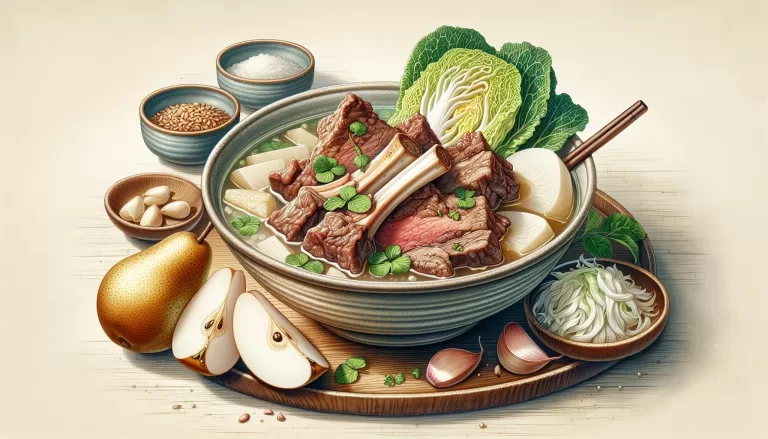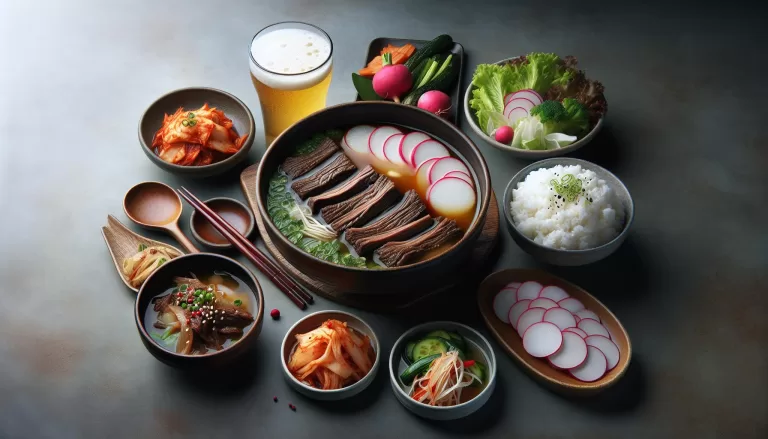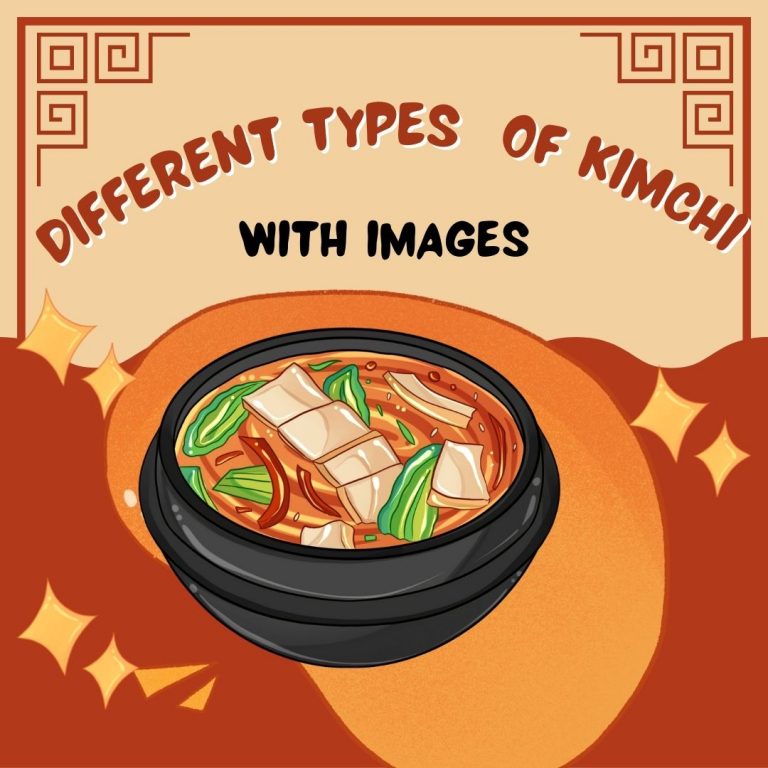Easy and Flavorful Homemade Pa Muchim Scallion Salad Recipe That Pairs Perfectly with Korean BBQ

Ingredients for Homemade Pa Muchim Scallion Salad
When you’re about to make your own Pa Muchim Scallion Salad, pay attention to the ingredients. Fresh quality ingredients do a number on the final flavour. They’re the stepping stones to a robust, healthy, and most importantly, delicious salad.
Here’s what you’ll need:
Table 1: Core Ingredients for Pa Muchim Scallion Salad
| Ingredients | Volume |
|---|---|
| Korean or Japanese Scallions | 2 Bunches |
| Soy Sauce | 2 Tablespoons |
| Red Chili Pepper Flakes (Gochugaru) | 1 Tablespoon |
| Granulated Sugar | 1 Teaspoon |
| Sesame Seeds | 1 Teaspoon |
| Sesame Oil | 1 Teaspoon |
Don’t fret if you can’t find Korean or Japanese scallions. Regular green onions will suffice. Here’s a little secret for you: adding a splash of rice vinegar will give it an extra kick. It’s unconventional but it just works!
Approximate nutritional values for the culinary adventurer who’s looking into the health benefits can be seen in the table below:
| Nutrition | Value |
|---|---|
| Calories | 80 |
| Carbs (g) | 6 |
| Protein (g) | 3 |
| Fat (g) | 4 |
| Vitamins | A, C, E, and B6 |
Let’s not stop at the ingredients. Continue on this journey and bring the flavour of Korea to your kitchen with the promised Pa Muchim Scallion Salad preparation steps. Find yourself immersed in the ‘how-to’ process, surely leading you to a delectable dining experience and possibly a newfound love for Korean Cuisine.
Step-by-step Instructions to Prepare Pa Muchim Scallion Salad
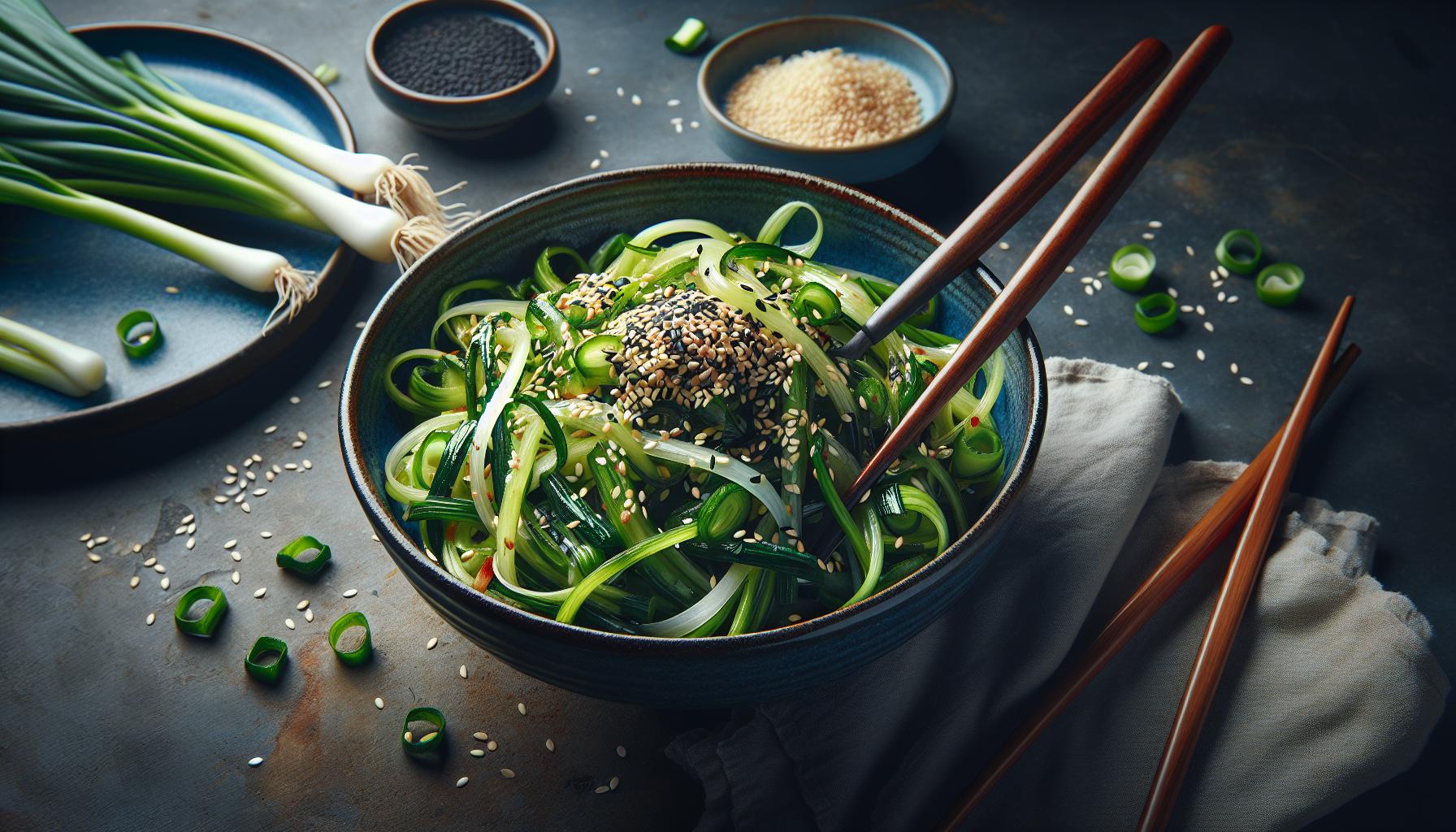
Ready to dive into the savory world of Korean cuisine? Here’s your roadmap.
Step 1 – Gather all your Ingredients
Your first step, of course, is gathering all the fresh, high-quality ingredients you need:
- Scallions: 15 sprigs, fresh
- Red pepper flakes: 2 tablespoons, Korean
- Soy sauce: 1 tablespoon
- Vinegar: 1 tablespoon
- Sugar: 1 tablespoon
- Sesame seeds: 1 tablespoon, roasted
For those who can handle a bit more heat, you may choose to add one teaspoon of wasabi paste for an extra kick.
Step 2 – Preparing the Scallions
With your ingredients in tow, start by cleaning the scallions thoroughly. Slice them into pieces about 1.5 inches long.
Step 3 – Mixing the Salad
Next, mix together your red pepper flakes, soy sauce, vinegar, and sugar in a large bowl. This concoction’s the dressing for our vibrant salad. Stir it around until the sugar dissolves completely. For those who love a little twist, now’s the time to add that optional wasabi paste into the mix.
Step 4 – Making the Final Product
Finally, toss the scallions into the bowl. Give them a good mix. You want every piece to be coated with that delicious dressing. Sprinkle the sesame seeds over the top, and there you have it.
Instead of a traditional salad, mix things up with this flavorful Korean dish. Your guests will thank you.
**Remember, this aromatic salad is not just delicious but also packs quite a nutritional punch. **
| Ingredient | Calories | Carbs | Protein | Fat |
|---|---|---|---|---|
| Scallions | 10 | 2.4g | 0.6g | 0.1g |
| Red pepper flakes | 6 | 1.3g | 0.2g | 0.3g |
| Soy sauce | 8 | 0.8g | 1g | 0g |
| Vinegar | 3 | 0.1g | 0g | 0g |
| Sugar | 49 | 12.6g | 0g | 0g |
| Sesame seeds | 52 | 2.1g |
Tips for Enhancing the Flavor of Your Scallion Salad

Your journey into the world of Korean cuisine continues as you delve into these handy tips for creating a scrumptious Pa Muchim scallion salad. The intensity of the spice, the tenderness of the scallions, and the balance of all flavors are key aspects to consider when making this savory dish.
Take, for instance, the scallions. Sure, they’re the main ingredient but it’s easy to overlook their importance. Always opt for fresh scallions. They give your salad that vibrant green hue and crisp, sharp, flavor.
Pepper flakes add some heat to the dish, so choose quality Korean red pepper flakes. Not only does it provide an interesting twist of flavor, but it can also impart a tantalizing color to your dish. Still too spicy? Don’t worry, you can adjust the quantity to suit your taste.
Soy sauce is another ingredient you can finetune. Less sodium soy sauce could be an alternative if you’re keeping an eye on your intake without compromising on flavor.
Let’s talk about vinegar. Vinegar gives your salad its characteristic sour note. Rice vinegar often does wonders here, but why not experiment a little? A splash of apple cider vinegar can add a fruity edge to your salad. Mix and match different types of vinegars to find what tantalizes your taste buds the most.
Sugar stands as the sweet counterpart to vinegar’s tang. It not just tones down the sharp flavors, but also amps up that beloved familiar taste in Korean cooking. A switch to brown or raw sugar could be an interesting tweak to your dish, adding a deeper, caramel-like sweetness.
Last but not least, lightly toasted sesame seeds. Instantly boost your dish’s nutty aroma and intensity by toasting your sesame seeds. Make sure that the seeds become golden brown, but be careful not to burn them.
Feel free to experiment with these tips and find your own perfect blend of flavors. Remember, the key to a good scallion salad lies in the balance of flavors and freshness of ingredients. Now, ready to up your Korean cooking game?
- Fresh scallions
- Quality Korean red pepper flakes
- Less sodium soy sauce
- Different types of vinegars
- Brown or raw sugar
- Lightly toasted sesame seeds
Health Benefits of Including Scallions in Your Diet
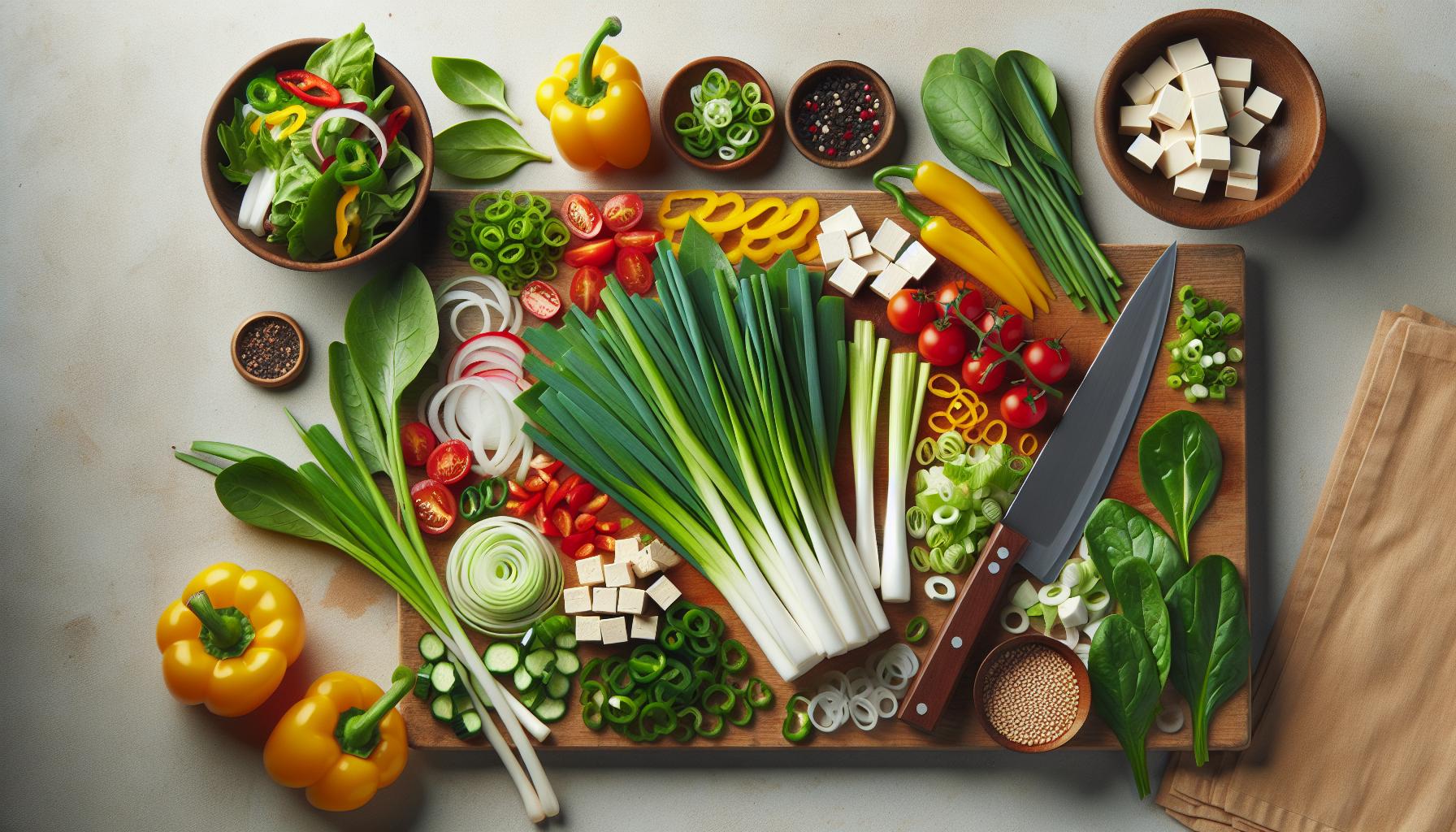
Whether you’re already a fan or just now discovering the versatility of scallions, you’ll no doubt appreciate the bonus: an array of health benefits this veggie brings to the party.
Scallions are packed with nutrients. They’re particularly rich in vitamin K, essential for blood clotting and bone health, and vitamin A, crucial for good vision and a strong immune system. Just 1/2 cup of chopped scallions provides about 60% of the daily value of vitamin K and 22% of vitamin A. This veggie is also teeming with vitamin C and dietary fiber.
Dietary fiber is instrumental in maintaining a healthy digestive system. It aids in preventing constipation and promoting regular bowel movement. Moreover, the vitamin C in scallions acts as a powerful antioxidant, protecting your body from free radical damage.
The selenium in scallions contributes to reproductive health, DNA production and protecting the body from infection. They’re also fortified with calcium and potassium – essential for bone health and maintaining blood pressure levels.
And there’s more! Scallions are low in calories but high in flavonoids, specifically quercetin. Quercetin is a powerful antioxidant with anti-inflammatory properties, contributing to heart health.
Here’s a tabular representation of the vital nutrients found in scallions:
| Nutrient | Amount |
|---|---|
| Vitamin K | 60% DV |
| Vitamin A | 22% DV |
| Vitamin C | 9% DV |
| Fiber | 7.3% DV |
| Selenium | 6.45% DV |
| Potassium | 2% DV |
| Calcium | 2% DV |
Just imagine, all these powerful nutrients are crammed into the pa muchim scallion salad you’ll soon be enjoying. They’re not merely enhancing the flavor of this salad but also infusing it with a medley of health benefits.
In your journey of Korean cooking, balance in flavor isn’t the only factor to focus on. Nutritional balance forms an equally vital part of the mix. After all, isn’t it a bonus when delicious can also mean nutritious?
Serving Suggestions and Pairing Options
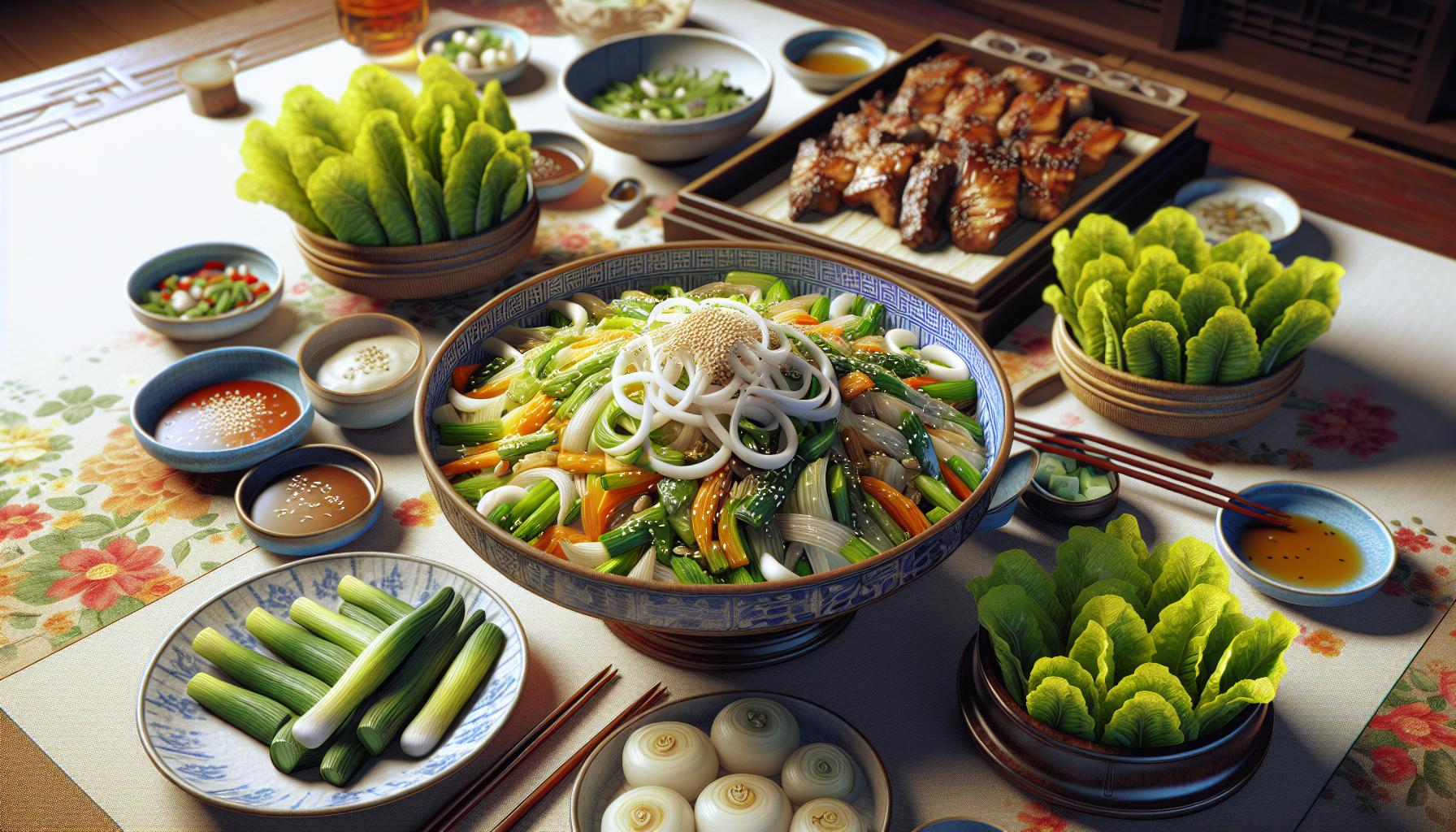
So you’ve mastered making pa muchim. Now you’re probably wondering, “What’s the best way to serve this scallion salad? What does it pair well with?” Well, you’re in luck! Pa muchim is a versatile side dish that goes well with a variety of main courses.
Pairings for Pa Muchim Scallion Salad
First off, let’s remember that pa muchim is often served as a banchan. That’s a side dish in Korean meals. It’s fantastic with barbecue dishes. Specifically, it adds a refreshing crunch and flavor contrast to bold, smoky barbecue meats like samgyeopsal (grilled pork belly) or bulgogi (marinated beef).
Just picture this: Tasty grilled meatloaf in a fresh lettuce wrap. A generous scoop of pa muchim. A dollop of ssamjang (spicy Korean dipping sauce). Sounds heavenly, doesn’t it?
Of course if barbecue isn’t on the menu, don’t fret. Pa muchim also partners well with simple grilled or fried fish. It brings a brightness that cuts through the rich, oily flavours wonderfully.
If you’re a fan of tofu, you’re in for a treat. The combination of spicy, tangy pa muchim with soft, bland tofu makes for a memorable meal.
Serving Guidelines for Pa Muchim Scallion Salad
When it comes to serving your pa muchim, it’s traditional to use small, shallow dishes. Typically each person gets their own dish of pa muchim.
Should you choose to, you can sprinkle a dash of sesame seeds or red pepper flakes over the top as a finishing touch. But it’s perfect as is. So there’s no pressure to gild the lily.
Take note, though, this salad is best served fresh. It can lose its crispness if left standing for too long. So it’s recommended to serve it soon after preparation.
So there you have it. Your guide to serving and pairing your delicious, nutritious pa muchim. Now go forth. Enjoy your foray into the exciting world of Korean cuisine.
Conclusion
So, you’ve learned how to elevate your meals with the versatile pa muchim scallion salad. It’s not just a side dish, it’s a game-changer. Whether you’re grilling pork belly, frying fish, or simply serving tofu, this Korean salad adds a spicy, tangy edge that’s hard to resist. Remember, the key is in the freshness, so serve it up crisp and enjoy it right away. Don’t forget the optional sesame seeds or red pepper flakes to give your salad that extra punch. Now it’s your turn to bring a taste of Korean cuisine to your table with this nutritious and flavorful dish. Enjoy your culinary journey!
